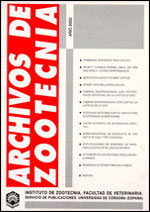Ver ítem
- xmlui.general.dspace_homeCentros e Institutos de InvestigaciónCIA. Centro de Investigaciones de AgroindustriaInstituto de Tecnología de AlimentosArtículos científicosxmlui.ArtifactBrowser.ItemViewer.trail
- Inicio
- Centros e Institutos de Investigación
- CIA. Centro de Investigaciones de Agroindustria
- Instituto de Tecnología de Alimentos
- Artículos científicos
- Ver ítem
Effect of slaughter handling conditions and animal temperament on bovine meat quality markers = Efecto del manejo y del temperamento animal sobre indicadores de calidad de la carne bovina
Resumen
The aim of this research was to study the effect of different handling conditions on physiological stress indicators and meat quality of beef cattle by studying animals with different temperaments. Forty animals classified by their temperament (calm and disturbed) were used. They were fed on pastures and finished with a mixed diet of corn grain and pasture. Biochemical indicators of animal stress were measured at slaughter (packed cell volume -PCV-,
[ver mas...]
The aim of this research was to study the effect of different handling conditions on physiological stress indicators and meat quality of beef cattle by studying animals with different temperaments. Forty animals classified by their temperament (calm and disturbed) were used. They were fed on pastures and finished with a mixed diet of corn grain and pasture. Biochemical indicators of animal stress were measured at slaughter (packed cell volume -PCV-, proteins, glucose, creatinine, alkaline phosphatase -APactivity,
cortisol, insulin, glycogen). Also, ultimate pH and instrumental colour were chosen as meat quality markers. Animal temperament showed a significantly increase (p<0.05) on PCV levels and a significantly (p<0.05) decrease on muscle glycogen. Besides, levels of plasma glucose and total proteins showed significant (p<0.05) differences associated to management applied. Meat quality markers (pH and colour) did not show significant differences according to handling conditions or temperament. Mean cortisol levels at the exsanguination time were significantly higher (p<0.05) than the values obtained one week prior to slaughter, which suggests an important effect of stress associated to slaughter procedures. It would be interesting to focus attention on theassessment of acute stress at abattoir, in order to improve handling protocols, and therefore to assure meat quality in Argentinean beef production systems.
[Cerrar]
El objetivo del presente trabajo fue estudiar el
efecto de diferentes condiciones de manejo sobre
indicadores fisiológicos de estrés y de calidad de
carne en bovinos con temperamentos contrastantes.
Se utilizaron cuarenta animales clasificados
como calmos y excitables. Los mismos fueron
alimentados inicialmente a base de pasturas y
terminados con una dieta mixta de grano de maíz
y pasturas. Se dosaron indicadores bioquímicos
de estrés
[ver mas...]
El objetivo del presente trabajo fue estudiar el
efecto de diferentes condiciones de manejo sobre
indicadores fisiológicos de estrés y de calidad de
carne en bovinos con temperamentos contrastantes.
Se utilizaron cuarenta animales clasificados
como calmos y excitables. Los mismos fueron
alimentados inicialmente a base de pasturas y
terminados con una dieta mixta de grano de maíz
y pasturas. Se dosaron indicadores bioquímicos
de estrés (hematocrito, proteínas plasmáticas,
glucosa, creatinina, actividad fosfatasa alcalina,
cortisol, insulina, contenido muscular de glucó-
geno). Como indicadores de calidad de carne se
midieron el pH de 24 h y color instrumental. El
temperamento animal demostró un incremento
significativo (p<0,05) en los niveles de hematocrito
y con una disminución significativa (p<0,05) del
glucógeno muscular. Los niveles de glucemia y de
proteínas totales mostraron modificaciones significativas
(p<0,05) asociadas con el manejo. El incremento (p<0,05) en los niveles plasmáticos de
cortisol durante la faena, independientemente del
tratamiento o el temperamento animal, sugiere un
importante efecto estresor por parte del proceso
de faena. Sería interesante centrar la atención en
el estudio del estrés agudo, a fin de mejorar
protocolos de manejo animal, y consecuentemente,
optimizar la calidad de la carne asociada en los
sistemas de producción de Argentina.
[Cerrar]

Fuente
Archivos de zootecnia, 62 (239) : 399-409. (Sept. 2013)
Fecha
2013-09
ISSN
0004-0592
1885-4494 (Online version)
1885-4494 (Online version)
Formato
pdf
Tipo de documento
artículo
Palabras Claves
Derechos de acceso
Abierto
 Excepto donde se diga explicitamente, este item se publica bajo la siguiente descripción: Creative Commons Attribution-NonCommercial-ShareAlike 2.5 Unported (CC BY-NC-SA 2.5)
Excepto donde se diga explicitamente, este item se publica bajo la siguiente descripción: Creative Commons Attribution-NonCommercial-ShareAlike 2.5 Unported (CC BY-NC-SA 2.5)


